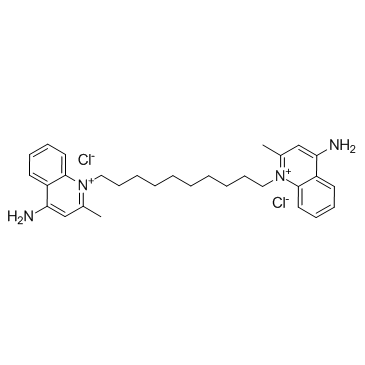522-51-0
| Name | dequalinium chloride |
|---|---|
| Synonyms |
Quinolinium, 1,1'-(1,10-decanediyl)bis[4-amino-2-methyl-, dichloride
DECA efisol dekamin evazol le chlorure de dequalinium dekadin EINECS 208-330-9 1,1'-Decan-1,10-diylbis(4-amino-2-methylchinolinium)dichlorid BADQ-10 1,1'-(1,10-Decanediyl)bis(4-amino-2-methylquinolinium) dichloride dequadin eriosept 1,1'-Decane-1,10-diylbis(4-amino-2-methylquinolinium) dichloride Dequalinium Chloride dequavet baqd10 Dequadin chloride Quinolinium, 1,1'-(1,10-decanediyl)bis[4-amino-2-methyl-, chloride (1:2) MFCD00063502 Dequalinium (Chloride) |
| Description | Dequalinium Chloride is a selective blocker of apamin-sensitive K+ channels.Target: Potassium ChannelDequalinium Chloride is a selective blocker of apamin-sensitive K+ channels. Treatment with Dequalinium chloride did not influence conditions caused by haemolytic streptococci -- verified by bacteriological examinations of pharyngeal smears -- inspite of its efficiency in vitro [1]. Dequalinium chloride (DECA), a cationic, lipophilic mitochondrial poison, selectively targets the mitochondrial membrane of certain epithelial carcinoma cells, in which it inhibits cellular energy production. Higher DECA doses under either regimen induced severe toxic effects and mortality [2]. |
|---|---|
| Related Catalog | |
| References |
| Melting Point | ≥300 °C(lit.) |
|---|---|
| Molecular Formula | C30H40Cl2N4 |
| Molecular Weight | 527.571 |
| Exact Mass | 526.263000 |
| PSA | 59.80000 |
| LogP | 1.34060 |
| Storage condition | 2-8°C |
CHEMICAL IDENTIFICATION
HEALTH HAZARD DATAACUTE TOXICITY DATA
|
| Hazard Codes | Xi:Irritant; |
|---|---|
| Risk Phrases | R36/37/38 |
| Safety Phrases | S26-S36 |
| RIDADR | NONH for all modes of transport |
| WGK Germany | 3 |
| RTECS | VA0700000 |
| HS Code | 2933499090 |
| HS Code | 2933499090 |
|---|---|
| Summary | 2933499090. other compounds containing in the structure a quinoline or isoquinoline ring-system (whether or not hydrogenated), not further fused. VAT:17.0%. Tax rebate rate:13.0%. . MFN tariff:6.5%. General tariff:20.0% |
